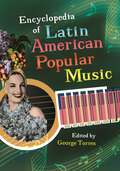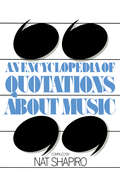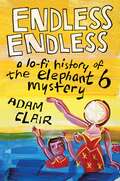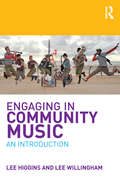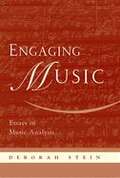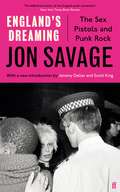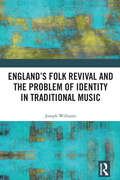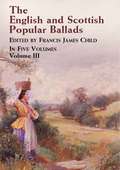- Table View
- List View
Encyclopedia of Latin American Popular Music
by George TorresThis comprehensive survey examines Latin American music, focusing on popular—as opposed to folk or art—music and containing more than 200 entries on the concepts and terminology, ensembles, and instruments that the genre comprises.The rich and soulful character of Latin American culture is expressed most vividly in the sounds and expressions of its musical heritage. While other scholars have attempted to define and interpret this body of work, no other resource has provided such a detailed view of the topic, covering everything from the mambo and unique music instruments to the biographies of famous Latino musicians.Encyclopedia of Latin American Popular Music delivers scholarly, authoritative, and accessible information on the subject, and is the only single-volume reference in English that is devoted to an encyclopedic study of the popular music in this genre. This comprehensive text—organized alphabetically—contains roughly 200 entries and includes a chronology, discussion of themes in Latin American music, and 37 biographical sidebars of significant musicians and performers. The depth and scope of the book's coverage will benefit music courses, as well as studies in Latin American history, multicultural perspectives, and popular culture.
Encyclopedia of Latin American Popular Music
by George TorresThis comprehensive survey examines Latin American music, focusing on popular—as opposed to folk or art—music and containing more than 200 entries on the concepts and terminology, ensembles, and instruments that the genre comprises.The rich and soulful character of Latin American culture is expressed most vividly in the sounds and expressions of its musical heritage. While other scholars have attempted to define and interpret this body of work, no other resource has provided such a detailed view of the topic, covering everything from the mambo and unique music instruments to the biographies of famous Latino musicians.Encyclopedia of Latin American Popular Music delivers scholarly, authoritative, and accessible information on the subject, and is the only single-volume reference in English that is devoted to an encyclopedic study of the popular music in this genre. This comprehensive text—organized alphabetically—contains roughly 200 entries and includes a chronology, discussion of themes in Latin American music, and 37 biographical sidebars of significant musicians and performers. The depth and scope of the book's coverage will benefit music courses, as well as studies in Latin American history, multicultural perspectives, and popular culture.
An Encyclopedia of Quotations About Music
by Nat ShapiroWriting about music-about what it is and what it means-is akin to describing the act of love. Somehow, the reduction of the experience to an unblushingly detailed exposition of how, where, when, and why who does what to whom, from prelude to resolu tion, loses everything in the translation. The other extreme, the one wherein the writer, in desperation, resorts to metaphor (with or without benefit of meter and rhyme), most often results in im agery that is banal, vulgar, inane, obscure, pretentious, and almost always insufferably romantic. To achieve good and accurate writing about music is as rare an accomplishment as expert wine-tasting, lion-taming, diamond-cut ting, truffie-finding and (if one just happens to be an unconverted Mohican brave) deer-tracking. Only the intuitive, the pure, the sensual, and the intrepid need apply. Professional musicians often evidence a fixed tendency either to rudely ignore or else to actively despise those of us who bravely try to understand, define, and describe their art. To many composers and instrumentalists, those outsiders (nonmusicians) who have the temerity to discuss anything more abstract than the digital dexterity of a fiddler, the particular vanity of a conductor, or the wage scales for overtime recording sessions are judged worthy only of contempt or-at the most-patronizing tolerance. "Music means itself," insists one of the contributors to the collection that follows, and many practitioners of the art of organ ized sound would prefer to leave it at that.
The End of Early Music: A Period Performer's History of Music for the Twenty-First Century
by Bruce HaynesPart history, part explanation of early music, this book also plays devil's advocate, criticizing current practices and urging experimentation. Haynes, a veteran of the movement, describes a vision of the future that involves improvisation, rhetorical expression, and composition.
The End of Early Music: A Period Performer's History of Music for the Twenty-First Century
by Bruce HaynesPart history, part explanation of early music, this book also plays devil's advocate, criticizing current practices and urging experimentation. Haynes, a veteran of the movement, describes a vision of the future that involves improvisation, rhetorical expression, and composition.
The end-of-the-century party: Youth, pop and the rise of Madchester
by Steve RedheadMadchester may have been born at the Haçienda in the summer of 1988, but the city had been in creative ferment for almost a decade prior to the rise of acid house. The end-of-the-century party is the definitive account of a generational shift in popular music and youth culture, what it meant and what it led to. First published right after the Second Summer of Love, it tells the story of the transition from new pop to the political pop of the mid-1980s and its deviant offspring, post-political pop. Resisting contemporary proclamations about the end of youth culture and the rise of a new, right-leaning conformism, the book draws on interviews with DJs, record company bosses, musicians, producers and fans to outline a clear transition in pop thinking, a move from an obsession with style, packaging and synthetic sounds to content, socially conscious lyrics and a new authenticity. This edition is framed by a prologue by Tara Brabazon, asking how we can reclaim the spirit, energy and authenticity of Madchester for a post-youth, post-pop generation. It is illustrated with iconic photographs by Kevin Cummins.
The end-of-the-century party: Youth, pop and the rise of Madchester
by Steve RedheadMadchester may have been born at the Haçienda in the summer of 1988, but the city had been in creative ferment for almost a decade prior to the rise of acid house. The end-of-the-century party is the definitive account of a generational shift in popular music and youth culture, what it meant and what it led to. First published right after the Second Summer of Love, it tells the story of the transition from new pop to the political pop of the mid-1980s and its deviant offspring, post-political pop. Resisting contemporary proclamations about the end of youth culture and the rise of a new, right-leaning conformism, the book draws on interviews with DJs, record company bosses, musicians, producers and fans to outline a clear transition in pop thinking, a move from an obsession with style, packaging and synthetic sounds to content, socially conscious lyrics and a new authenticity. This edition is framed by a prologue by Tara Brabazon, asking how we can reclaim the spirit, energy and authenticity of Madchester for a post-youth, post-pop generation. It is illustrated with iconic photographs by Kevin Cummins.
Endless Endless: A Lo-Fi History of the Elephant 6 Mystery
by Adam ClairAn inspiring, revelatory exploration of the genesis and impact of the fabled Elephant 6 collective and the baffling exodus of its larger-than-life luminary, Neutral Milk Hotel frontman Jeff Mangum Years after its release, Neutral Milk Hotel&’s In the Aeroplane Over the Sea remains one of the most beloved and best-selling albums in all of indie music, hailed as a classic so influential as to be almost synonymous with the ongoing vinyl revival. But despite its outsized impact, a question looms even larger: why did frontman Jeff Mangum, just as the record propelled him to the brink of music superstardom, choose instead to disappear entirely? The mystery has perplexed listeners for decades—until now. In barely two years, Neutral Milk Hotel rose from house show obscurity in Athens, Georgia, to widespread hype and critical acclaim, selling out rock clubs across the country and gracing the tops of numerous year-end best-of lists. But just as his band was reaching the escape velocity necessary to ascend from indie rock success to mainstream superstar, Mangum hit the eject button. After the 1998 release of Aeroplane and a worldwide tour to support it, Mangum stopped playing shows, releasing new music, or even doing interviews. He never explained why, not even to his friends or colleagues, but thanks to both the strength of Aeroplane and his vexing decision to walk away from rock stardom, Neutral Milk Hotel&’s impact only grew from there. In Endless Endless, Adam Clair finds the answer to indie rock&’s biggest mystery, which turns out to be much more complicated and fascinating than the myths or popular speculation would have you believe. To understand Mangum and Neutral Milk Hotel and Aeroplane requires a deep dive into the unconventional inner workings of the mercurial collective from which they emerged, the legendary Elephant 6 Recording Company. Endless Endless details the rise and fall of this radical music scene, the lives and relationships of the artists involved and the colossal influence that still radiates from it, centered around the collective&’s accidental figurehead, one of the most idolized and misunderstood artists in the world, presenting Mangum and his collaborators in vividly human detail and shining a light into the secret world of these extraordinary and aggressively bizarre artists. Endless Endless offers unprecedented access to this notoriously mysterious collective, featuring more than 100 new interviews and dozens of forgotten old ones, along with never-before-seen photos, answering questions that have persisted for decades while also provoking new ones. In this deeply researched account, Endless Endless examines not just how the Elephant 6 came to be so much more than the sum of its parts, but how community can foster art—and how art can build community.
Energy Flash: A Journey Through Rave Music and Dance Culture
by Simon ReynoldsTwenty-five years since acid house and Ecstasy revolutionized pop culture, Simon Reynolds's landmark rave history Energy Flash has been expanded and updated to cover twenty-first-century developments like dubstep and EDM's recent takeover of America.Author of the acclaimed postpunk history Rip It Up and Start Again, Reynolds became a rave convert in the early nineties. He experienced first-hand the scene's drug-fuelled rollercoaster of euphoria and darkness. He danced at Castlemorton, the illegal 1992 mega-rave that sent spasms of anxiety through the Establishment and resulted in the Criminal Justice and Public Order Bill. Mixing personal reminiscence with interviews and ultra-vivid description of the underground's ever-changing sounds as they mutated under the influence of MDMA and other drugs, Energy Flash is the definitive chronicle of electronic dance culture.From rave's origins in Chicago house and Detroit techno, through Ibiza, Madchester and the anarchic free-party scene, to the pirate-radio underworld of jungle and UK garage, and then onto 2000s-shaping genres such as grime and electro, Reynolds documents with authority, insight and infectious enthusiasm the tracks, DJs, producers and promoters that soundtracked a generation. A substantial final section, added for this new Faber edition, brings the book right up to date, covering dubstep's explosive rise to mass popularity and America's recent but ardent embrace of rave. Packed with interviews with participants and charismatic innovators like Derrick May, Goldie and Aphex Twin, Energy Flash is an infinitely entertaining and essential history of dance music.
Engaging in Community Music: An Introduction
by Lee Higgins Lee WillinghamEngaging in Community Music: An Introduction focuses on the processes involved in designing, initiating, executing and evaluating community music practices. Designed for both undergraduate and graduate students, in community music programmes and related fields of study alike, this co-authored textbook provides explanations, case examples and ‘how-to’ activities supported by a rich research base. The authors have also interviewed key practitioners in this distinctive field, encouraging interviewees to reflect on aspects of their work in order to illuminate best practices within their specialisations and thereby establishing a comprehensive narrative of case study illustrations. Features: a thorough exploration and description of the emerging field of community music; succinctly and accessibly written, in a way in which students can relate; interviews with 26 practitioners in the US, UK, Australia, Europe, Canada, Scandinavia and South Africa, where non-formal education settings with a music leader, or facilitator, have experienced success; case studies from many cultural groups of all ages and abilities; research on life-long learning, music in prisons, music and ritual, community music therapy, popular musics, leisure and recreation, business and marketing strategies, online communities – all components of community music.
Engaging in Community Music: An Introduction
by Lee Higgins Lee WillinghamEngaging in Community Music: An Introduction focuses on the processes involved in designing, initiating, executing and evaluating community music practices. Designed for both undergraduate and graduate students, in community music programmes and related fields of study alike, this co-authored textbook provides explanations, case examples and ‘how-to’ activities supported by a rich research base. The authors have also interviewed key practitioners in this distinctive field, encouraging interviewees to reflect on aspects of their work in order to illuminate best practices within their specialisations and thereby establishing a comprehensive narrative of case study illustrations. Features: a thorough exploration and description of the emerging field of community music; succinctly and accessibly written, in a way in which students can relate; interviews with 26 practitioners in the US, UK, Australia, Europe, Canada, Scandinavia and South Africa, where non-formal education settings with a music leader, or facilitator, have experienced success; case studies from many cultural groups of all ages and abilities; research on life-long learning, music in prisons, music and ritual, community music therapy, popular musics, leisure and recreation, business and marketing strategies, online communities – all components of community music.
Engaging Students with Music Education: DJ decks, urban music and child-centred learning
by Pete DaleEngaging Students with Music Education is a groundbreaking book about using DJ decks and urban music in mainstream schools to re-engage disaffected learners and develop a curriculum which better reflects overall contemporary tastes. Many young learners are ‘at risk’ of exclusion; this book argues that for such individuals, the implications of such a shift in the music curriculum could be especially positive. Drawing extensively on the author’s own wealth of teaching experience, and bridging the gap between practice and theory, this book demonstrates through case studies that DJ decks can prove extremely valuable in mainstream classroom situations across the secondary school age ranges. Addressing challenging and crucial topics, combining rigorous theoretical analysis with practical suggestions, the book addresses questions such as: Are DJ decks actually a musical instrument, and are they suitable for classroom teaching? Will Ofsted's school inspectors approve of music teaching involving DJ decks and urban music? If we bring urban music into the classroom, will this further marginalise classical music? Are DJing and MCing skills recognised within examination specifications, at least in the UK? Current teachers will find the practical advice on how to incorporate DJ decks and urban music into their classroom especially helpful, whilst educational researchers will be captivated by the critical discussion of the child-centred tradition and a theoretical approach which stretches from ‘continental’ philosophy to practice-based reflection. With an insistence that the starting point for music education should always be the interests and experiences of the learners, this book is essential reading for those music teachers and researchers interested in the benefits of non-standard music-making in the classroom.
Engaging Students with Music Education: DJ decks, urban music and child-centred learning
by Pete DaleEngaging Students with Music Education is a groundbreaking book about using DJ decks and urban music in mainstream schools to re-engage disaffected learners and develop a curriculum which better reflects overall contemporary tastes. Many young learners are ‘at risk’ of exclusion; this book argues that for such individuals, the implications of such a shift in the music curriculum could be especially positive. Drawing extensively on the author’s own wealth of teaching experience, and bridging the gap between practice and theory, this book demonstrates through case studies that DJ decks can prove extremely valuable in mainstream classroom situations across the secondary school age ranges. Addressing challenging and crucial topics, combining rigorous theoretical analysis with practical suggestions, the book addresses questions such as: Are DJ decks actually a musical instrument, and are they suitable for classroom teaching? Will Ofsted's school inspectors approve of music teaching involving DJ decks and urban music? If we bring urban music into the classroom, will this further marginalise classical music? Are DJing and MCing skills recognised within examination specifications, at least in the UK? Current teachers will find the practical advice on how to incorporate DJ decks and urban music into their classroom especially helpful, whilst educational researchers will be captivated by the critical discussion of the child-centred tradition and a theoretical approach which stretches from ‘continental’ philosophy to practice-based reflection. With an insistence that the starting point for music education should always be the interests and experiences of the learners, this book is essential reading for those music teachers and researchers interested in the benefits of non-standard music-making in the classroom.
Engelbert - What's In A Name?: My Autobiography
by Engelbert HumperdinckThe man known simply as 'Enge' by his millions of fans worldwide has sold over 150 million records and is in the Guinness Book of Records for achieving 56 consecutive weeks in the chart with 'Release Me'.From living on the dole and receiving last rites with tuberculosis, to buying a Hollywood palace with a heart-shaped pool and a fleet of fourteen Rolls Royces, Engelbert wears his 'King of Romance' crown so well that horticulturists even named a rose after him. And the love god has certainly lived up to his reputation, indulging in a string of affairs and one-night stands, whilst remaining happily married to his first love Patricia. Forty years on from his early hits 'Enge' is still at the very top, selling out concerts across the world, representing the UK at the 2012 Eurovision Song Contest, and topping the charts in all the major markets.Inspired by the warmth of his millions of affectionate fans and the endless support of his wife, Engelbert shares his incredible life story with openness, humour and astonishing honesty.
Engineering of Music for the Digital Age: Creativity in Musical Composition
by Jeffrey Ewing Steven SimskeMusical scores – like literature, poetry, and technical manuals – are documents. The central tenet of this book is that musical composition in the digital age is a form of document engineering. In essence, music shares with other forms of creative content generation – from poetry to prose, and from science to science fiction – the need for structure, flow, and sources for creativity.Musical composition is considered in this book as the creative process of engineering musical documents with regards to its arrangement, form, texture, and instrumentation, etc. This "document" then instructs a performance or the creation of an alternative document, such as a recording. In this book, the arrangement of phrases, patterns, and structures seen in music will be illustrated to give new composers a starting point to begin planning and making decisions about their own compositions.The book will also guide those who need assistance in completing a piece. While this is a book about musical composition, it is not meant to be a manual on music theory. Instead, the book keeps its focus on the structural elements of a composition. Its aim is to give the audience a structural road map for composing; whether they are starting a piece from the first note, having a melody in mind already, or need help overcoming a creative hurdle. The book examines compositions that clearly define a form or technique. Among the key compositional elements are: Form, Phrase, Period, and Expression in Composition Rhythm/Motive Melody and Harmony Tonal Center Mode Mixture and Modulation Accompaniment/Instrumentation/Orchestration Composition Techniques and Notation Targeted examples cover all stages of writing a piece, helping to build the reader’s composition from the first note into a complete work without promoting a style or harmonic practice. Each chapter contains a sidebar addressing helping the composer to add creative sources for the music making process. Finally, the book concludes with a chapter on creativity in terms of how composed music can affect our lives and even our fairy tales.
Engineering of Music for the Digital Age: Creativity in Musical Composition
by Jeffrey Ewing Steven SimskeMusical scores – like literature, poetry, and technical manuals – are documents. The central tenet of this book is that musical composition in the digital age is a form of document engineering. In essence, music shares with other forms of creative content generation – from poetry to prose, and from science to science fiction – the need for structure, flow, and sources for creativity.Musical composition is considered in this book as the creative process of engineering musical documents with regards to its arrangement, form, texture, and instrumentation, etc. This "document" then instructs a performance or the creation of an alternative document, such as a recording. In this book, the arrangement of phrases, patterns, and structures seen in music will be illustrated to give new composers a starting point to begin planning and making decisions about their own compositions.The book will also guide those who need assistance in completing a piece. While this is a book about musical composition, it is not meant to be a manual on music theory. Instead, the book keeps its focus on the structural elements of a composition. Its aim is to give the audience a structural road map for composing; whether they are starting a piece from the first note, having a melody in mind already, or need help overcoming a creative hurdle. The book examines compositions that clearly define a form or technique. Among the key compositional elements are: Form, Phrase, Period, and Expression in Composition Rhythm/Motive Melody and Harmony Tonal Center Mode Mixture and Modulation Accompaniment/Instrumentation/Orchestration Composition Techniques and Notation Targeted examples cover all stages of writing a piece, helping to build the reader’s composition from the first note into a complete work without promoting a style or harmonic practice. Each chapter contains a sidebar addressing helping the composer to add creative sources for the music making process. Finally, the book concludes with a chapter on creativity in terms of how composed music can affect our lives and even our fairy tales.
England's Dreaming: The Sex Pistols And Punk Rock
by Jon SavageJon Savage's Ralph Gleason Award-winning England's Dreaming is the ultimate book on punk, its progenitors, the Sex Pistols, and their time: the late 1970s. Full of anedcote, insight, and exclusive interviews, it tells the sensational story of the meteoric rise and rapid decline of the last great rock'n'roll band and the cultural moment they came to define.The critical reputation of England's Dreaming has grown over the past decade and a half. This updated edition includes an introduction focusing on the legacy of punk twenty-five years on, an account of the Sex Pistols 1996 reunion, and a comprehensively updated discography.
England’s Folk Revival and the Problem of Identity in Traditional Music
by Joseph WilliamsEstablishing an intersection between the fields of traditional music studies, English folk music history and the philosophy of Gilles Deleuze and Félix Guattari, this book responds to the problematic emphasis on cultural identity in the way traditional music is understood and valued. Williams locates the roots of contemporary definitions of traditional music, including UNESCO-designated intangible cultural heritage, in the theory of English folk music developed in 1907 by Cecil Sharp. Through a combination of Deleuzian philosophical analysis and historical revision of England’s folk revival of the Victorian and Edwardian eras, Williams makes a compelling argument that identity is a restrictive ideology that runs counter to the material processes of traditional music’s production. Williams reimagines Sharp’s appropriation of Darwinian evolutionary concepts, asking what it would mean today to say that traditional music ‘evolves’, in light of recent advances in evolutionary theory. The book ultimately advances a concept of traditional music that eschews the term’s long-standing ontological and axiological foundations in the principle of identity. For scholars and graduate students in musicology, cultural studies, and ethnomusicology, the book is an ambitious and provocative challenge to entrenched habits of thought in the study of traditional music and the historiography of England’s folk revival.
England’s Folk Revival and the Problem of Identity in Traditional Music
by Joseph WilliamsEstablishing an intersection between the fields of traditional music studies, English folk music history and the philosophy of Gilles Deleuze and Félix Guattari, this book responds to the problematic emphasis on cultural identity in the way traditional music is understood and valued. Williams locates the roots of contemporary definitions of traditional music, including UNESCO-designated intangible cultural heritage, in the theory of English folk music developed in 1907 by Cecil Sharp. Through a combination of Deleuzian philosophical analysis and historical revision of England’s folk revival of the Victorian and Edwardian eras, Williams makes a compelling argument that identity is a restrictive ideology that runs counter to the material processes of traditional music’s production. Williams reimagines Sharp’s appropriation of Darwinian evolutionary concepts, asking what it would mean today to say that traditional music ‘evolves’, in light of recent advances in evolutionary theory. The book ultimately advances a concept of traditional music that eschews the term’s long-standing ontological and axiological foundations in the principle of identity. For scholars and graduate students in musicology, cultural studies, and ethnomusicology, the book is an ambitious and provocative challenge to entrenched habits of thought in the study of traditional music and the historiography of England’s folk revival.
The English and Scottish Popular Ballads, Volume 1
by Francis James ChildThe rich field of English balladry was virgin territory before Francis James Child entered it. The few published ballad editions that existed were unreliable, filled with unacknowledged editorial changes and distortions of the original manuscripts. Professor Child compiled all the extant ballads with all known variants, and made them available for the first time — together with his invaluable commentary that prefaces each work — in a single source that maintained absolute fidelity to the original texts. Published between 1882 and 1898, the original ten-part study became the definitive collection of popular ballads in the English language, never to be superceded. To this day, scholars and devotees speak of "The Child Ballads" with the awe and respect generated by few other literary works. Volume 1: Parts I and II of the original set, ballads 1-53 including "Edward," "Lord Randal," "Tam Lin," "Lady Isabel and the Elf-Knight," "Earl Brand," "Thomas Rymer," more. Biographical sketch of Child by Prof. Kittredge, Child's portrait, additions and corrections.
The English and Scottish Popular Ballads, Volume 2
by Francis James ChildPublished between 1882 and 1898, this definitive collection compiles all the extant ballads with all known variants and features the Child's commentary for each work. Volume II includes Parts III & IV of the original set — ballads 54–113: "Sir Patrick Spens," "Johnie Scot," "Child Maurice," "Fair Margaret and Sweet William," more.
The English and Scottish Popular Ballads, Volume 3
by Francis James ChildPublished between 1882 and 1898, this definitive collection compiles all the extant ballads with all known variants and features Child's commentary for each work. Volume III includes Parts V and VI of the original set — ballads 114–188: "Mary Hamilton," "Flodden Field," "Sir Andrew Barton," and more than 30 ballads about Robin Hood.
The English and Scottish Popular Ballads, Volume 4
by Francis James ChildPublished between 1882 and 1898, this definitive collection compiles all the extant ballads with all known variants and features Child's commentary for each work. Volume IV includes Parts VII and VIII of the original set — ballads 189-265: including "Rob Roy," "Sir James the Rose," "Geordie," "The Gypsy Laddie," "The New-Slain Knight," more.
The English and Scottish Popular Ballads, Volume 5
by Francis James ChildPublished between 1882 and 1898, this definitive collection compiles all the extant ballads with all known variants and features Child's commentary for each work. Volume 5 includes Parts IX and X of the original set — ballads 266-305 — plus a 3000-item bibliography, indexes, glossary, musical selections and an essay by Walter Morris Hart.
